- Home
- Barry Unsworth
Crete Page 8
Crete Read online
Page 8
One thing which makes Knossos different from all other Minoan sites on Crete is the reconstructions that were carried out by Sir Arthur Evans—as he by then had become—mainly in the course of the 1920s. In his passion for what he had discovered, his desire to protect the recently exposed remains from the weather, his wish to make the layout of the palace more easily understood by the visitor, he used the architectural details he found in fresco fragments to reconstruct some of the buildings, making use of bricks, metal girders, and cement to rebuild the columns and door lintels destroyed in those distant fires.
Knossos: Shield frescoes from the head of the grand staircase
This use of modern materials caused heated arguments at a time when there was a strongly romantic feeling about ancient remains. Evans was called the “builder of ruins” in the French press. Many people since then have felt that he went too far, that his use of the frescoes was too subjective. But there can be no doubt that he saved some important buildings from collapse, among them the grand staircase of the palace, regarded as unique in architectural history, with five flights of stairs still preserved in situ.
Unreconstructed, altogether less adorned and distinctly less crowded, are the palace of Festos, second largest of the Minoan palaces, overlooking the bay of Mesaras on the south coast, and the smaller palace of Agia Triada two miles nearer the coast. These are sites rich in archaeological interest with superb views over the plain of Mesara to the Libyan Sea. I am not by nature very exacting when it comes to exploring ancient remains. It doesn’t really give me any great satisfaction to know whether this niche or that was actually the family shrine, or precisely how high the staircase was, or—in any detail—how the water pipes were all joined up. I would only forget these things again. Making precise identifications on these Minoan sites is a headache anyway, for clues are scanty, and on-site information even scantier. Wandering here on a summer morning with the evidence of ancient life all around one, the olive groves and vineyards covering the plain below, the majestic peaks of Psiloritis rising to the north and the warm breath of Africa against your face—it is difficult to imagine a pleasanter way of spending an hour or two.
In 1908, inside a small chamber at Festos, one of the most famous finds in the history of Minoan excavation was made, the disk of baked clay, later to be known as the Festos Disk, dating from around 1700 B.C. Its provenance is still disputed, but the evidence indicates that it was made in Crete. At present housed in the Archaeological Museum of Iraklion, it is something truly to marvel at, a solid disk roughly six inches in diameter, completely covered back and front with ideographs inscribed in spiral form from the circumference to the center, 241 signs in all, among them running figures, heads crowned with feathers, ships, shields, birds and beasts and insects, each one impressed with great care on the wet clay using some kind of stamp. And all this several thousand years before Gutenberg!
Despite a century of efforts to decipher the script, no agreement has yet been reached. Various theories have been advanced. Was it a hymn to the Lord of the Rain, a set of building instructions, a list of provisions for the army, an anthem to a pantheon of gods? Some pretty unlikely solutions have been offered. At different times, linguists have sought to demonstrate that the text derives from Basque, or Finnish, or Magyar.
The road back to Iraklion branches northward at Agii Deka, and soon afterward runs past the ruins of ancient Gortyn, which was a Minoan city but saw its greatest power and importance in the classical period, first under the Greeks and then under the Romans. Three momentous landings outline the story of the city, the first of them—naturally, since this is Crete—mythological. Zeus, having fallen in love with Europa, a daughter of Agenor, king of Tyre in Phoenicia, assumed the form of a beautiful white bull. He seemed so gentle, the girl was enchanted by him and was eventually persuaded to climb on his back. Before she knew what was happening, she was riding out to sea, on the way to Crete. He brought her to Gortyn, where they became lovers. One of their three sons was Minos, whose throne room we got a thirty-second view of at Knossos. Crete then, not only gave Europe its name, it was where Europe began, a truth Cretans have always known.
The second landing occurred in the first century A.D., that of Titus, the disciple of St. Paul, who appointed him first bishop of Crete and gave him the task of overseeing the early Christian church on the island. “For this cause I left thee in Crete,” the Apostle says in his Epistle to Titus, “that thou shouldst set in order the things that are wanting.” Paul’s opinion of the Cretans, as we have seen, was not very high. Titus was martyred at Gortyn, and the ruins of the sixth-century basilica of the cross-in-square type that was built on the site of his martyrdom are among the most impressive to be seen here, with three apses and a section of the vaulting still standing. Under the Romans Gortyn became capital of the province of Crete and Libya, with a population of a quarter million, and it continued in wealth and importance under the Byzantines, who took over the island in A.D. 330.
The third landing—and the last—was that of the Saracens in A.D. 825. In accordance with their general policy throughout the island, they visited the city with fire and sword, and it was never rebuilt.
Legendary beginnings, a period of glory, total devastation—it is a familiar paradigm in the history of Crete. There is an abiding desolation in the remains of Gortyn that I have not felt elsewhere among the ruined cities of Crete, probably due to the huge area over which the ruins are spread. They extend on either side of the road, acre after acre of them, through thickets of bramble and choked ditches and plowed fields and olive groves. The local people have used the marble of temples and the granite of churches to repair their walls. Gortyn, especially on the south side of the road in the area bordering the River Mitropolitanos, provides a striking example of a universal process: the reversion of buildings to ruins and ruins to rubble and rubble to dust. This feeling gives a melancholy to the place and seems to rub away the distinctions of time and period: The ruins of the Roman governor’s palace, or of the Greek temple to Pythian Apollo, seem no older than the broken walls of an abandoned sheep pen. It is the same with people: The dead belong to one state and one period only.
To rescue one from melancholy, there is always the vitality and warmth of the people and the unfailing charm of the landscape, which can turn the accidental or unplanned into memorable experience. The region northwest of Gortyn is spectacularly beautiful. One day, in an attempt to go on foot from the village of Vorizia to the Valsamonero Monastery, we took a wrong turn. We realized our mistake after a while, but continued along the track we were on, impelled by the wildness and purity of the light among these hills—like the first light of the world—and by the play of shadow on the mountain peaks to the north, still capped with snow. The olive trees were in flower and the air was full of birdsong. Incredibly ancient, these olives, the trunks twisted and gnarled into tormented shapes. Seeing them, it is easy to understand the pervasive stories of metamorphosis found in Greek myths and in the Latin poets who inherited them. Poems of escape from death or ravishment, last-minute rescues by some suddenly compassionate god, plants struggling to turn into humans, humans striving to find escape in plants.
The olive was already cultivated on this island two thousand years before Christ. It is easy to believe, seeing these time-wrenched shapes, that some of the present trees go back that far. They don’t, of course, not quite, but one of the oldest olive trees in Europe is on Crete, at Loutro in Sfakia, with annual rings that date to well over two thousand years ago. Any olive with a diameter of seven feet or so will go back to the Middle Ages.
The path climbed up into the hills and there were ravens nesting in the crags above us and a kestrel circling below and, above the olives, great spreads of the splendid Greek fir, which you rarely see at altitudes of less than two thousand feet. This tree is dedicated to Pan, god of shepherds. He and Vorias (the North Wind) were both in love with a nymph called Pitys. She chose Pan as being less blustering and turbulent. In rev
enge Vorias blew her off a cliff. Pan found her dying and transformed her into his sacred tree, the fir, which was called Pitys in memory of her. Since then she cries every time the north wind blows, and her tears are the drops of resin that drip from her cones in autumn.
We tramped for a good many miles that day and were given a handful of oranges when we came to lower ground by gravely courteous people who quite clearly thought we were out of our minds to be clambering about when there was no need. I thanked them in Greek, which may at least have served to reassure them that we were not from some altogether different planet. Dusk fell, there was no time, we didn’t see the Valsamonero Monastery, with its fifteenth-century frescoes, painted by Konstantinos Rikos and said to be among the finest in Crete. But the monastery gave us a great trip and one can’t ask more than that. As the Alexandrian Greek poet Kavafis says in his poem about Ithaka, the kingdom of Odysseus, who found his way back there from Troy after many adventures, it’s no use asking anything from the island when you finally arrive: It has already made you the supreme gift of the journey.
There is one monument at Gortyn which has endured in much the same way that the olive trees have, strongly rooted like them. When the Odeon, or Covered Theater, was built here about A.D. 100, in the time of the Emperor Trajan, a much older wall was incorporated, as it had been incorporated in a succession of earlier buildings—a wall inscribed in Dorian Greek with a code of laws dating from the fifth century B.C. Over six hundred lines in length, the script reads one line from left to right, the next from right to left, so that the eye can follow the text continuously. It is the first codified system of laws known to Europe and one of the most amazing documents in existence anywhere.
Not that it illustrates the principle of equality before the law, so dear to us today, and even today more common in the breach than the observance. These are the laws of a society that was still tribal, still governed by rigid distinctions of caste. For rape committed against a free person the fine was 1,200 obols, while for the rape of a household slave the fine went from one to 24 obols, “depending on circumstances.” What strikes us today is not the particular notion of justice contained in the statutes, but the reverence with which they have been treated over such a great span of time, the beauty of the lettering, the continuous incorporation into new buildings as the old ones crumbled away. An early example, however unequal the laws, of that striving for order, for shelter from violence and chaos common to every human society. The form of the Odeon can still be made out: the semicircle of the amphitheater, some remains of benches, but most of it now is little more than broken stones. The Gortyn Code, however, is still intact, an abiding monument to the principle of legality. It is housed now in its own brick shelter, protected from the weather. Protected from people too—you can only look at it from a distance, through bars.
Having seen where the people we call Minoans lived, and formed some idea of their surroundings and the circumstances of their lives, the natural progression is to go on to see the things they made. Whatever reservations one has about the attractiveness of modern Iraklion, the city’s archaeological museum is one of the finest to be found anywhere, and its collection of Minoan artifacts quite unique. Here, beautifully displayed in room after room, are the objects that give physical expression to the spirit of that remote society, and trace the way that spirit developed and changed, from its beginnings in the Neolithic period ten thousand years ago to the high culture of the Palace period, between 2000 and 1450 B.C., and on to the time of invasion from the mainland and subsequent decline.
Among a huge variety of objects from all over Minoan Crete—Knossos, Malia, Festos, Tylissos, Zacros, Agia Triada, Gournia—are some that through the fame and mystery that surrounds them have become semi-legendary. Here is the Festos Disk, already mentioned, exquisite and baffling, printed on fresh clay three and a half thousand years ago, making it the first ever printed document. Here is the sarcophagus found in a tomb in the precincts of the palace at Agia Triada, its surface completely covered with painted plaster, depicting scenes of ritual worship and the cult of the dead. Once again we are in the toils of speculation. The jar the priestess is emptying, does it contain blood? What is the significance of the black bird that sits between two double axes, or the model ship that one man is holding out to another? Such things remind us that for all the patience we can muster and all the resources for research at our disposal, there is a world of values and beliefs forever beyond the reach of our understanding.
Then there is the celebrated ivory figurine of the bull leaper, caught in the very moment he is vaulting the bull’s foreparts, about to perform the astounding somersault which will land him on his feet again on the other side of the animal. The musculature and anatomical form of the body are rendered with what seems absolute fidelity until one sees that the arms and legs are longer than they should be—a device we meet with in contemporary art, revolutionary then, designed to convey the grace of the movement without loss of tension. His hair is made separately, of bronze threads. Priest, gladiator, devotee, slave, star athlete, what was he?
From the same period and the same place—the palace at Knossos—are two faience figures of snake goddesses, one slightly taller than the other so perhaps mother and daughter, both with prominent, naked breasts and elaborate skirts and coiled snakes wreathed around arms and body—the smaller also holds up rampant snakes, one in each hand. The snake was a principal object of worship among the Minoans, for whom it represented eternity, immortality, and reincarnation. The goddesses were fashioned for small household shrines and worshiped as domestic divinities, guardians of the house.
For many, the crowning glory of the museum is the room containing the Kamares ware dating back to the Old Palace period. This beautiful pottery owes its name to the Kamares cave in the eastern zone of Psiloritis, where a great quantity of it was discovered. A group of Italian archaeologists, in the 1890s, exploring caves in this wild and rugged terrain, stumbled upon a treasure trove of painted pottery, some fragmented, some virtually whole, bowls, cups, jugs, amphora, all of unique quality. This came at a time when almost nothing was known about the Minoans. They had not even been named yet, the work of excavation at Knossos had not yet properly begun. I have never read an account of this discovery, but I like to imagine that the magnitude of it came to them only gradually and with growing delight as they moved here and there in the recesses of the cavern, the light from their lamps falling on these heaps of pots, which had rested so long unseen and unappreciated, retaining their glowing colors in the dark of the cave.
Now we know what they at the time didn’t, that most of this pottery was fashioned in the palace workshops of Knossos and Festos. They superbly illustrate the Minoan feeling for dynamic movement based on interweaving patterns. The tentacles of an octopus, the shoots and tendrils of a plant, the fronds of a palm tree mingle with abstract curvilinear designs, spiral and coil and turn in on themselves, in a way that recalls yet again the stories of the labyrinth, that seemingly endless elaboration and extension of rooms in the palaces. Perhaps the maze, as idea and as design, was a fundamental element of Minoan sensibility.
So we wandered from room to room in this splendid museum, tracing the development of a culture, a search for form, which is a search also for meaning, through all the meanderings of taste and fashion. A strong religious feeling is expressed here, and a joy in natural forms and in the pleasures of the senses. There is no depiction of war. The Minoan people, throughout most of their history, enjoyed that sort of freedom from predators that allows animals or insects to flourish in certain habitats. The only way to attack Crete was by sea, and for that a strong navy was needed, but no one in the Mediterranean world of that time seems to have possessed such a navy—except the Cretans themselves. The Minoan kingdom was a thalassocracy, a sovereignty of the sea. They traded far and wide, they established colonies, they cleared the sea routes of pirates, but they fought no battles on their own soil, until the final ones that put an end to th
em.
It was a combination of circumstances that brought them down. Between 1500 and 1450 B.C. Crete suffered a succession of earthquakes which damaged the centers of power, weakening the island so that it became vulnerable to invasion just at the time when the power of Mycenae on the Greek mainland was expanding. The Mycenaeans were the first to occupy the island. When their day was over, it was the turn of Greek tribes from the north, with their sky god and their iron weapons. More primitive than those they conquered, they were unable to absorb or adapt what they found, or put anything in place of what they destroyed. It was the beginning of a dark age in the eastern Mediterranean that was to last for some centuries. The palaces were never rebuilt and never again inhabited, the invaders regarding them as uncanny, haunted places. Writing disappeared completely; what art was produced was crude and botched.
In the objects on display in the last rooms on the ground floor one feels this crushing of the spirit as an almost palpable presence, like an affliction, as if the collective mind of this gifted people had been stricken by the equivalent in cultural terms of Alzheimer’s disease. There is an increasing number of large, crudely molded terra-cotta figures of goddesses with rounded lumps for breasts and blind, coarsened faces. Their arms are raised in the conventional posture of prayer. Stand away a little and look at these groups, and they seem like creatures in mourning for their own ruin and for their ruined world, raising their arms in terrible mute grief.

 Sacred Hunger
Sacred Hunger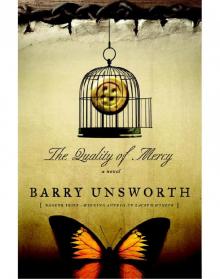 The Quality of Mercy: A Novel
The Quality of Mercy: A Novel The Songs of the Kings: A Novel
The Songs of the Kings: A Novel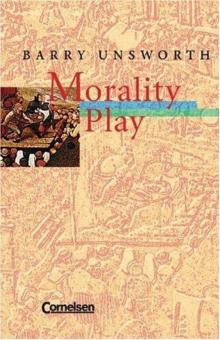 Morality Play. Mit Materialien. (Lernmaterialien)
Morality Play. Mit Materialien. (Lernmaterialien)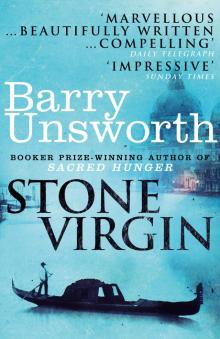 Stone Virgin
Stone Virgin Land of Marvels
Land of Marvels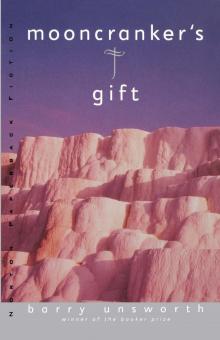 Mooncranker's Gift
Mooncranker's Gift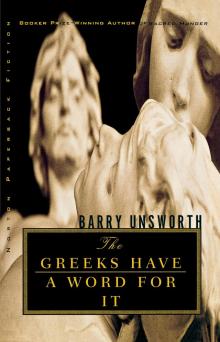 The Greeks Have a Word for It
The Greeks Have a Word for It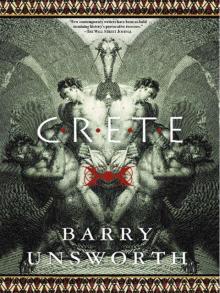 Crete
Crete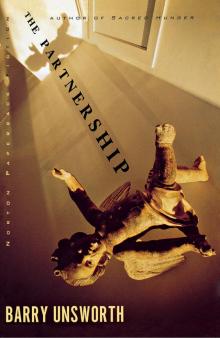 The Partnership
The Partnership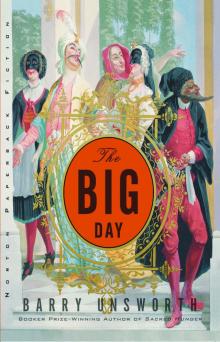 The Big Day
The Big Day The Hide
The Hide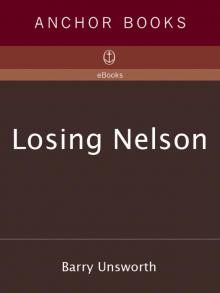 Losing Nelson
Losing Nelson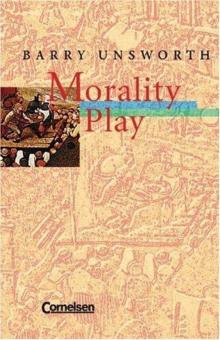 Morality Play
Morality Play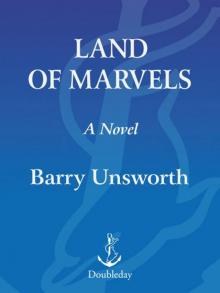 Land of Marvels: A Novel
Land of Marvels: A Novel The Ruby In Her Navel
The Ruby In Her Navel